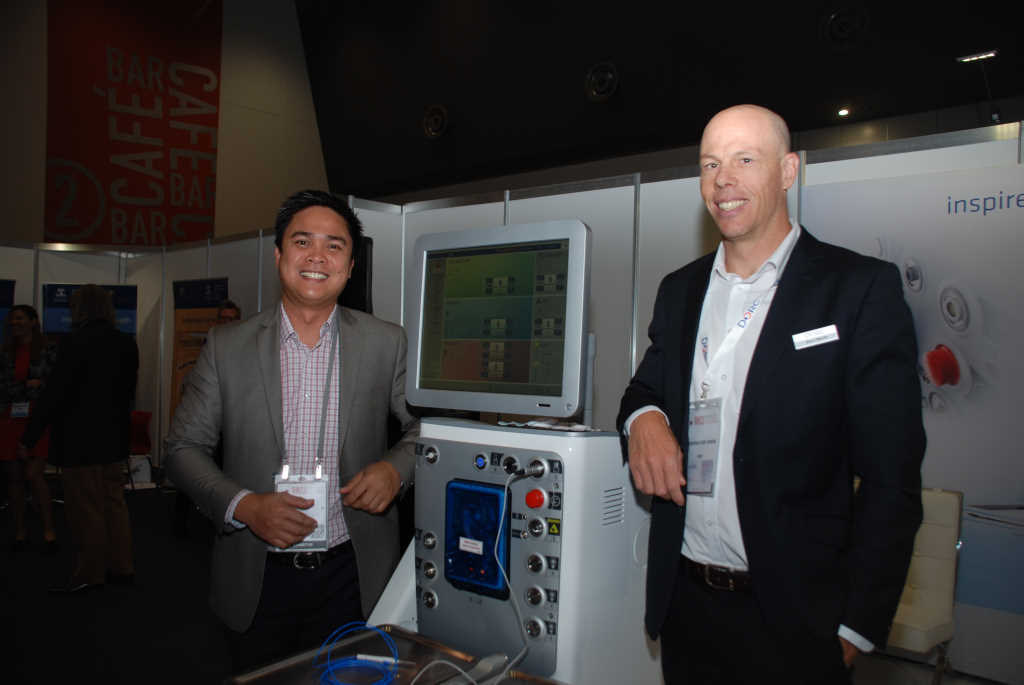Innovation at RANZCO 2017
As with all RANZCO conferences there was an excited buzz from the exhibition floor as the world’s ophthalmic companies unveiled their latest technological advances and encouraged the delegate doctors to try what was on offer, often for the first time. Here’s a selection of just some of the news from RANZCO 2017.
Alcon was showcasing a number of technologies at the RANZCO Congress, but attracting the most attention was the company’s suite of AcrySof IQ PanOptix intraocular lenses (IOLs) and its NGenuity 3D Visualisation System.
The AcrySof IQ PanOptix Toric IOL was launched in June 2017, completing the PanOptix family of IOL’s for patients with pre-existing corneal astigmatism undergoing cataract surgery. “It is a new option for astigmatic patients who seek to address their near, intermediate and distance vision needs with a single lens,” said Alcon in a statement.
Backed up by several clinical studies, referenced throughout Alcon’s PanOptix marketing material, Alcon said the new PanOptix Toric covers cyl corrections as low as 1.00 diopter. “(It offers) surgeons the confidence to deliver spectacle independence through Alcon’s proprietary Enlighten (enhanced light energy) optical technology… (and) overcomes some of the limitations of current trifocal technology by manipulating a quadrifocal diffractive design.
“This is the only IOL that delivers an intermediate focal point at 60cm, a distance preferred by many patients for intermediate vision activities, combined with the exceptional rotational and axial stability of the AcrySof single piece design.”
Alcon’s other latest innovation on show, and with its own trial room at RANZCO 2017, was NGenuity, a 3D visualisation platform for digitally-assisted vitreoretinal surgery. It allows retinal surgeons to operate looking at a high-definition 3D screen, instead of bending their necks to look through the eye-piece of a microscope, to improve surgeons' posture, which may also reduce fatigue, said Alcon. “With the three-dimensional view, the surgeon now has depth perception not previously available on standard television monitors, often used today in the operation theatre. Surgeons may also increase magnification while maintaining a wide field of view as well as use digital filters to customise his or her view during each procedure, highlighting ocular structures and tissue layers which is imperative to visualise the back of the eye.”
The NGenuity system has also been designed to minimise light exposure to the patient's eye, enabling the surgeon to operate with lower light levels, said the company.
Clinical studies and more information on both NGenuity and the PanOptix IOL family are available on Alcon’s website.
Device Technologies - endoscopy
Amid the multitude of high-tech devices on Device Technologies’ stand was a cleverly designed artificial eyeball used to help demonstrate Endo Optiks E2 Ophthalmic Laser Endoscopy System. The system simultaneously offers imaging and laser function, providing a minimally invasive glaucoma surgery (MIGS) approach to glaucoma management using endoscopic cyclophotocoagulation (ECP). Backed up by three-years of clinical data, ECP can be done through a phaco incision and adds just two to four minutes to your procedure time, said Rich Camarra, international director for Endo Optiks.
“Retina surgeons are now beginning to embrace endoscopy,” said Camarra, who had travelled from Boston to Perth to demonstrate his company’s endoscopy system, which has been designed specifically for ophthalmology and comes in a choice of straight and curved probe designs in various gauge sizes.
Allergan – Xen and Ozurdex
Allergan’s stand was divided into two with one half focused on its newly released Xen Gel Implant, for better glaucoma management, and the other on Ozurdex (dexamethasone 700mcg), which has just been approved in New Zealand for diabetic macular oedema.
The tiny Xen Gel Stent, is indicated for the management of refractory glaucomas, including cases where previous surgical treatment has failed; cases of primary open-angle glaucoma; and pseudoexfoliative or pigmentary glaucoma with open angles that are unresponsive to maximum tolerated medical therapy. Now available in New Zealand, Xen is being welcomed by ophthalmologists as a real alternative for glaucoma patients. For more, see news story on p3.
Ozurdex is also another welcome addition to New Zealand ophthalmologists’ armamentarium. A long-acting intravitreal steroid, delivered via a sustained-release ocular implant, Ozurdex is now funded for the treatment of macular oedema due to retinal vein occlusion and non-infectious uveitis affecting the posterior segment of the eye. For more, see pX.
Johnson & Johnson Vision (surgical) – iDesign
Taking pride of place on Johnson & Johnson Vision’s (formerly AMO’s) stand was the newly updated, iDesign Refractive Studio, the “first and only topo-integrated wavefront technology”.
Hannah Howard, J&J’s regional application support manager, surgical, said the new iDesign is very exciting as it’s the only device of its kind currently on the market. “At the moment, the only other options you have are wavefront-guided or topography-guided, you don’t have a combination of the two. So, what this is offering is the customisation of the wavefront aberrations, plus if there is any asymmetry or any corneal irregularities those are also taken into consideration. In just one click, the iDesign gives you 18 different diagnostic views.”
The five-in-one iDesign System captures more than 1,200 micro readings of the eye to give a precise refraction, said Tom Frinzi, J&J’s worldwide president, surgical. “The shape and curvature of the cornea are also precisely measured in a single three-second scan... enabling surgeons to measure the entire visual pathway and create an optical fingerprint unique to each patient’s eye… (ushering) in the next level of customisation.”
J&J has also doubled its surgical sales team in New Zealand (see story pX).
Zeiss – ultra-widefield imaging
Dominating Zeiss’ stand was the company’s new Clarus 500 ultra-widefield imaging device, which is currently being introduced to optometry and ophthalmology practices across Australasia. For more, see news story on pX.
OIC - DORC
Ophthalmic Instrument Company’s (OIC’s) Chris Malicdem was on hand on the Dutch Ophthalmic Research Center’s (DORC’s) stand to help introduce DORC’s brand new 27 gauge forceps, for use with DORC’s Enhancing Visual Acuity (EVA) Vitrectomy System.
The new 27 gauge forceps were developed in direct response to ophthalmologists’ wishes given that 27-gauge surgery is developing quite fast now, said David Maritz, DORC’s regional director. One of the main drawbacks, however, with tools this small has been flexibility as they can bend in the eye. But DORC’s 227-guage forceps have been strengthened so they have enhanced stiffness, said Maritz, and the grasping platforms have also been increased by 60%. “So you get a much, much stronger grasping power and holding force. It’s a massive improvement. It’s brand new here, but the feedback we’ve had from Europe is that this is fantastic.”
DORC also launched a new SF6 gas, used in retinal surgery, at RANZCO 2017.
Designs for Vision – Oculus Corvis ST
New on DFV’s stand was the updated Oculus Corvis ST, the first instrument to enable ophthalmologists to perform fast and comprehensive screenings for biomechanically weak corneas, said the company, recording the cornea’s reaction to a defined air pulse with a high-speed Scheimpflug-camera that takes over 4 300 images a second, to measure IOP and corneal thickness with far greater precision.
The Corvis ST is particularly useful for comprehensive biomechanical screening and keratoconus detection, said Ignatios Koukouras, DFV’s national product manager, diagnostic, at RANZCO 2017. “Nothing else in the world can measure corneal biomechanics like the Corvis. It is the only instrument that can actually determine the stiffening effect of corneal cross-linking.”
The Corvis also integrates with the Oculus Pentacam to provide an even more detailed corneal analysis, he added.


























